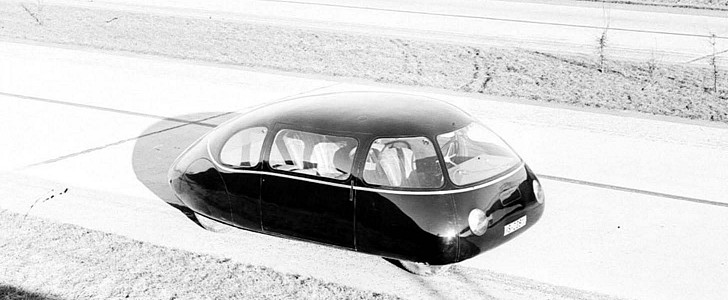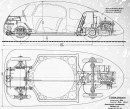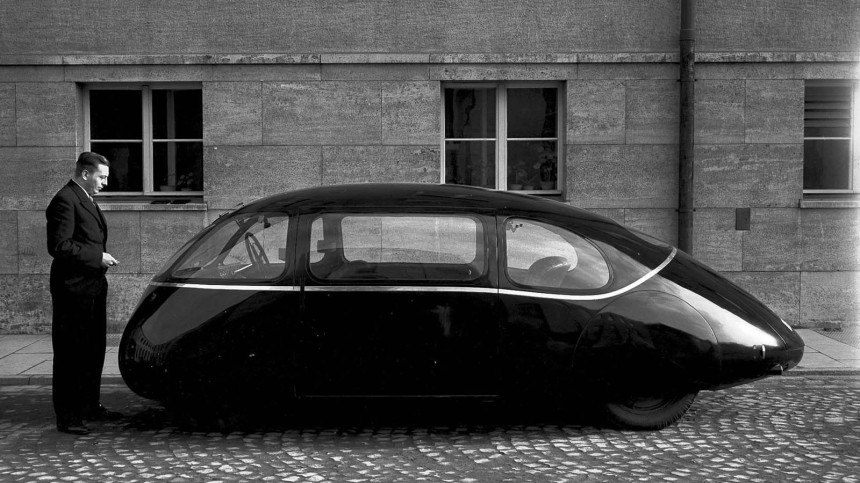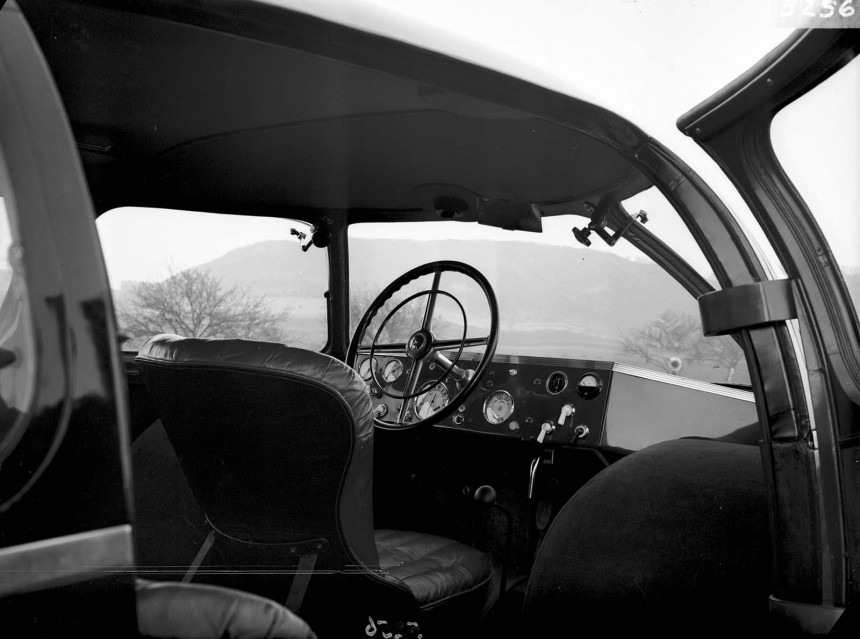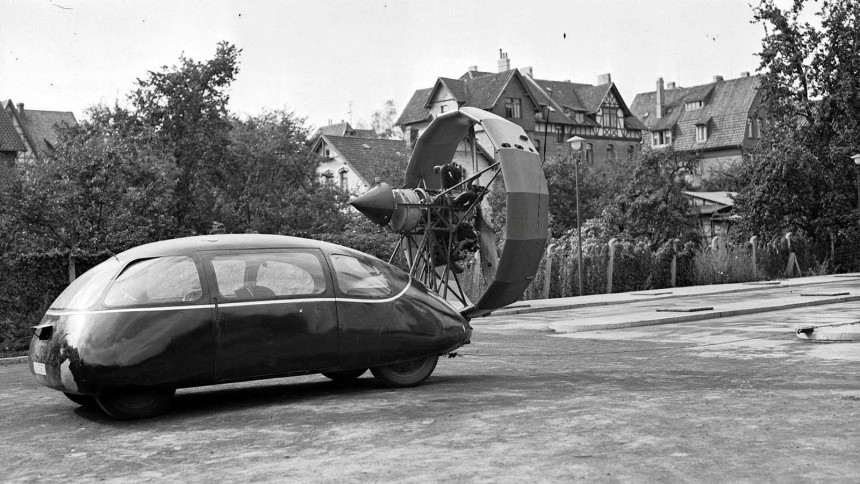A world without dreamers is a hopeless world, one in which the prospect of progress doesn’t exist. German engineer Karl Schlör was one such dreamer, and his work, specifically the Schlörwagen automobile, though swept away into oblivion, remains iconic.
The Schlörwagen was one of the first streamliners in the history of the automotive industry, a first and rather rudimentary attempt in the field of aerodynamics, but one that stood out from the rest. The Schlörwagen, a one-off prototype that was lost in the aftermath of World War II, was ultra-aerodynamic, though not much of a good passenger car.
December is Celebration Month on autoevolution, and, among other things we’re choosing to celebrate, we’re having a better look at some of the dream machines of the past. The Schlörwagen is one of them, a teardrop vehicle that dreamed to be the future Autobahn cruiser and set a new record, but also a big dreamer that failed just as spectacularly.
Karl Schlör was a German engineer with the Aerodynamic Research Institute (Aerodynamischen Versuchsanstalt, or AVA, renamed the German Aerospace Center, or DLR, in 1997) in Göttingeng. To put it bluntly, he knew a lot about planes, and, like many of his contemporaries, he wanted to bring some of the tech and features to road cars. The Autobahn network was, at the time, expanding rapidly across Germany, so Schlör wanted to use his aeronautical know-how to create a passenger vehicle with a very low drag coefficient.
In 1936, Schlör had already drawn the plans for such a car, which was directly inspired by the wing of an airplane. With backing from AVA, he built the first model for wind-tunnel testing, and the result was nothing short of spectacular, even by modern standards: a drag coefficient of 0.11. His theory proven, Schlör set out to build a functional model.
For that, he used the chassis of a Mercedes-Benz 170 H, with a rear engine and independent suspension, and had the body built by the Ludewig Brothers of Essen, out of aluminum, with rounded windows set flush into the body. The resulting vehicle had a wheelbase of 2.6 meters (8.5 feet), a total length of 4.33 meters (14.2 feet), and was 2.10 meters (6.8 feet) wide and 1.48 meters (4.8 feet) high. Inside, it could seat seven people in total, with the driver situated centrally and six passengers, three on each bench, on the sides.
The interior was very spacious, comparable to a first-generation Hummer. Sadly, comfort and the safety of whoever would ride in the Schlörwagen was not a concern: aerodynamic efficiency was. The prototype was wind-tunnel tested and, while the drag coefficient was poorer than with the scale model, it was still very good, at 0.18.
As Andreas Dillmann, head of the Institute of Aerodynamics and Flow Technology at the German Aerospace Center (DLR), put it a while back, “Basically, the Schlörwagen is a wing on wheels.” It flies on the road – flew, more like it – but it did so with little consideration for those inside. Real-world tests included a Mercedes-Benz 170 H, with the Schlörwagen performing better both in terms of speed and fuel consumption. At the time, Schlör claimed his teardrop-shaped vehicle could go even faster than the recorded 135 kph (83.8 mph), at 146 kph (90.7 mph).
The functional prototype was unveiled at the 1939 Berlin Auto Show, where it immediately earned the nicknames “Göttinger Egg,” the “Pillbug,” and “tortoise” because of its peculiar shape. Sadly, the same peculiarity of the shape led to the conclusion that the car was ugly, and visitors failed to appreciate its streamlined appearance for whatever improvements it brought in terms of aerodynamics. The fact that the Schlörwagen inherited the 170 H’s propensity to oversteer and was proving very unstable and unsafe in crosswinds did not help.
Neither did the outbreak of the war. The Schlörwagen was stored at the German Aerospace Center in Göttingen, where it was stripped of the steering wheel and the seats. However, before that happened, in 1942, it was brought out for a very strange and, one assumes, thrilling experiment. Engineers had found a Russian M-11 135 hp aircraft engine and strapped it to the back of the car for a couple of rounds on the test track.
In August 1948, after repeated attempts by Schlör to retrieve the Schlörwagen from the British Military Administration, it disappeared from storage. It was towed away and presumably dismantled – stolen – and lost for all eternity.
In 2014, to mark the 75th anniversary of the iconic car, Dillmann and the team at DLR put together a 1:5 scale model based on the original drawings, and wind-tunnel tested it. You can see the incredible results in the video below.
As of 2021, two separate manufacturers are working together to create replicas of the Schlörwagen. Dillmann concluded that the Schlörwagen was not feasible as a passenger car because of its exclusive focus on aerodynamics, saying that modern vehicles compromise on that in order to guarantee safety, reliability, and comfort. No word on whether the replicas will take the issues ignored by the original into considerations, but they’d better, to matter.
December is Celebration Month on autoevolution, and, among other things we’re choosing to celebrate, we’re having a better look at some of the dream machines of the past. The Schlörwagen is one of them, a teardrop vehicle that dreamed to be the future Autobahn cruiser and set a new record, but also a big dreamer that failed just as spectacularly.
Karl Schlör was a German engineer with the Aerodynamic Research Institute (Aerodynamischen Versuchsanstalt, or AVA, renamed the German Aerospace Center, or DLR, in 1997) in Göttingeng. To put it bluntly, he knew a lot about planes, and, like many of his contemporaries, he wanted to bring some of the tech and features to road cars. The Autobahn network was, at the time, expanding rapidly across Germany, so Schlör wanted to use his aeronautical know-how to create a passenger vehicle with a very low drag coefficient.
For that, he used the chassis of a Mercedes-Benz 170 H, with a rear engine and independent suspension, and had the body built by the Ludewig Brothers of Essen, out of aluminum, with rounded windows set flush into the body. The resulting vehicle had a wheelbase of 2.6 meters (8.5 feet), a total length of 4.33 meters (14.2 feet), and was 2.10 meters (6.8 feet) wide and 1.48 meters (4.8 feet) high. Inside, it could seat seven people in total, with the driver situated centrally and six passengers, three on each bench, on the sides.
The interior was very spacious, comparable to a first-generation Hummer. Sadly, comfort and the safety of whoever would ride in the Schlörwagen was not a concern: aerodynamic efficiency was. The prototype was wind-tunnel tested and, while the drag coefficient was poorer than with the scale model, it was still very good, at 0.18.
As Andreas Dillmann, head of the Institute of Aerodynamics and Flow Technology at the German Aerospace Center (DLR), put it a while back, “Basically, the Schlörwagen is a wing on wheels.” It flies on the road – flew, more like it – but it did so with little consideration for those inside. Real-world tests included a Mercedes-Benz 170 H, with the Schlörwagen performing better both in terms of speed and fuel consumption. At the time, Schlör claimed his teardrop-shaped vehicle could go even faster than the recorded 135 kph (83.8 mph), at 146 kph (90.7 mph).
Neither did the outbreak of the war. The Schlörwagen was stored at the German Aerospace Center in Göttingen, where it was stripped of the steering wheel and the seats. However, before that happened, in 1942, it was brought out for a very strange and, one assumes, thrilling experiment. Engineers had found a Russian M-11 135 hp aircraft engine and strapped it to the back of the car for a couple of rounds on the test track.
In August 1948, after repeated attempts by Schlör to retrieve the Schlörwagen from the British Military Administration, it disappeared from storage. It was towed away and presumably dismantled – stolen – and lost for all eternity.
In 2014, to mark the 75th anniversary of the iconic car, Dillmann and the team at DLR put together a 1:5 scale model based on the original drawings, and wind-tunnel tested it. You can see the incredible results in the video below.
